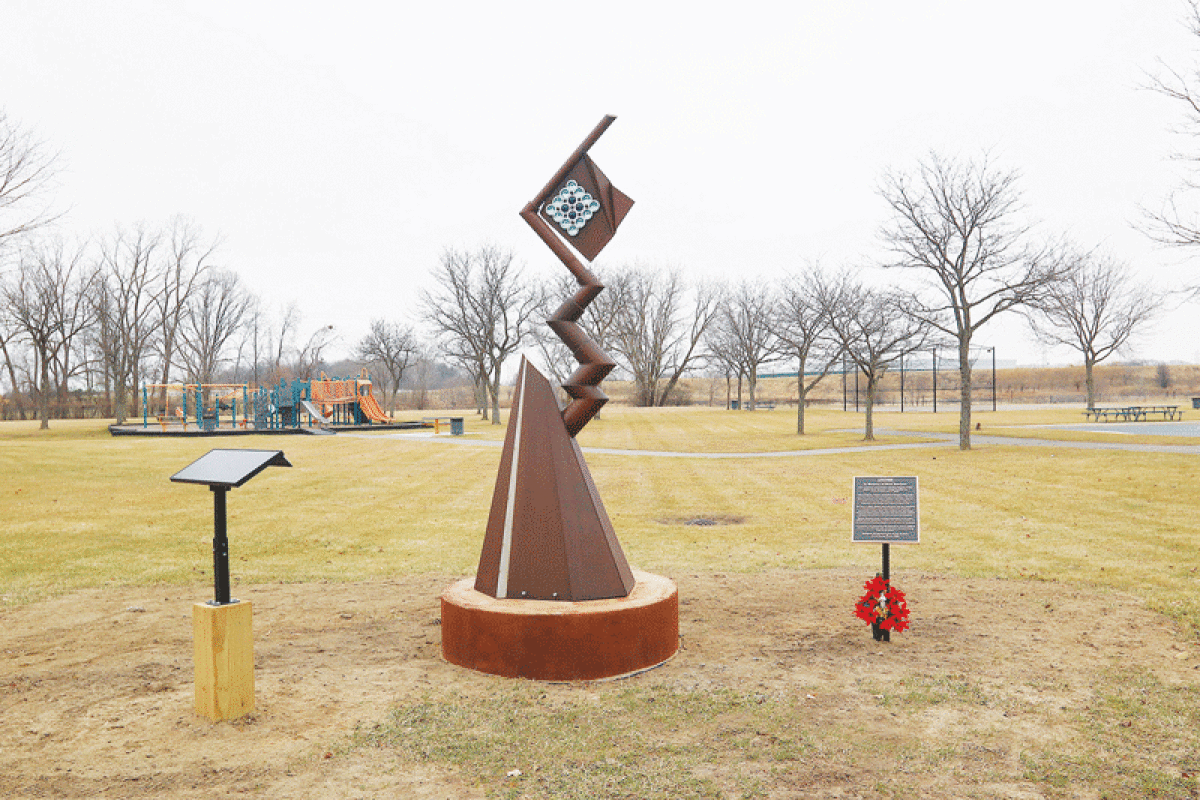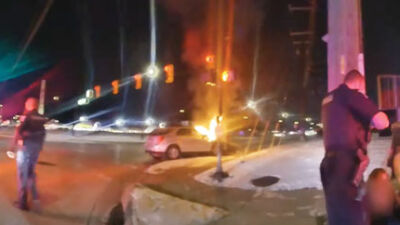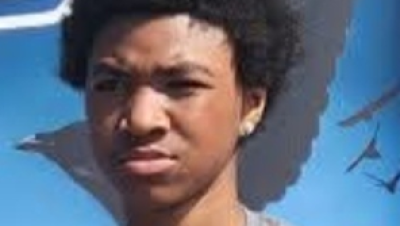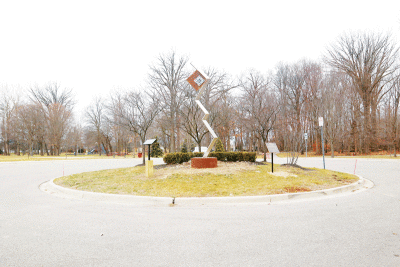
A Lifetree at Leroy H. Imus Park was installed in memory of Sterling Heights police Officer Leroy Imus, who was killed by a hit-and-run driver while on duty in 1971.
Photo by Erin Sanchez
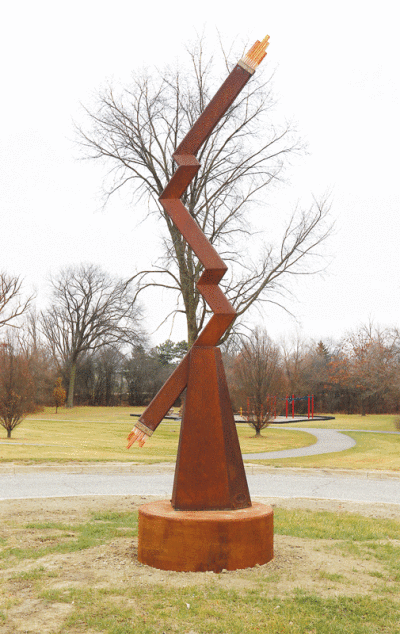
This Lifetree at Mark Sawyers Family Park honors police Officer Mark Sawyers, who was fatally shot while working for the Sterling Heights Police Department in 2004.
Photo by Erin Sanchez
STERLING HEIGHTS — Three new decorative monuments in Sterling Heights are more than the latest examples of Sterling Heights’ rollout of new public art — they are also meant to memorialize three police and fire personnel who died while performing their jobs.
During a Dec. 6 Sterling Heights City Council meeting, city officials presented three new public art sculptures that were set up Nov. 10, according to the city.
The three glass and steel sculptures, known as Lifetrees, each stand at around 16 feet, city officials said. According to city officials, the Lifetrees were partly made possible through the city’s Public Art Program, which was started in 2017 as a way to improve placemaking and the city’s identity.
During the meeting, City Manager Mark Vanderpool said public art is a quality-of-life issue, and he said the city has a collection worth “well over a million dollars.”
“It breaks down barriers. It forces individuals to come together and have discussions,” he said. “And like any piece of art, some individuals love it; some don’t. But it creates conversation, and it brings people together.”
Community Relations Director Melanie Davis said the program’s goals included installing public art beyond the city center campus. She credited the artists, the Detroit Design Center’s Erik and Israel Nordin, for their work, as well as Parks and Recreation Director Kyle Langlois for helping “push this project across the finish line.”
Erik Nordin said he and his brother, Israel, grew up in Sterling Heights, and they were also the artists behind “The Seed” sculpture at the roundabout of Utica and Dodge Park roads.
He described what it was like to make the Lifetrees.
“My brother and I talked about how proud we are to be able to create something for these officers,” Erik said.
“And, you know, reading through the stories of what … they did with their lives and how they changed others’ lives and gave their lives, there could be no greater honor as an artist to create something that tells a story and creates a memory for these great men.”
One sculpture installed at Leroy H. Imus Park represents police Officer Leroy Imus, who, in 1971, was killed in the line of duty by a hit-and-run driver during a traffic stop, according to Sterling Heights Police Chief Dale Dwojakowski.
Another sculpture at James C. Nelson Park honors the life of firefighter James Nelson. Nelson died while on duty in 1983, when he fell from a fire truck while on an emergency run, according to Assistant Fire Chief Shawn Allen.
The last sculpture is installed at Mark Sawyers Family Park, and it honors the life of police Officer Mark Sawyers. Sawyers was shot and killed in 2004 while working on a report in his police car, Dwojakowski said.
When it was time for the City Council to speak, Mayor Pro Tem Liz Sierawski said the new sculptures stand for something different than previous works like “The Seed.”
“It stands for specific people and their families and what they stood for and what they did,” Sierawski said. “They died in service of us, and so these things will stand … the test of time long after we’re gone, and they will stand the test of time to show that people do make a difference, and what they do will always be remembered.”
Mayor Michael Taylor said he hopes the new memorials make the families of the honored proud, and that “we are living up to the sacrifice that they made.” The mayor also praised the Nordin brothers’ craftsmanship.
“I think that they’ve hit it out of the park with this and that … these memorials will be something that you can be proud of,” he said.
According to Davis in a text message, the three sculpture installations and their accompanying plaques and solar lighting were approved by the city months ago for a maximum cost of $100,300. Davis added that the total cost was offset by $2,000 from the Fraternal Order of Police Lodge #118 Imus Park Endowment, which is held by the Sterling Heights Area Community Foundation.
More art to come
The city is continuing to acquire public art for future installation. At the Dec. 6 meeting, the council unanimously voted in its consent agenda to pay $34,000 toward installing a mosaic mural for the Sterling Heights Community Center’s ground floor. The mural’s artist will be Mary Gilhuly-Klaper. The piece will include resident-designed tiles, according to a city document.
At the end of the meeting, Councilman Michael Radtke said he hopes that the art program will put more public art throughout the entire city. He also said he hopes more businesses will get involved in being venues for art such as wall murals, adding that Ann Arbor, Jackson, Detroit and other cities have had success with murals.
“I’m just trying to figure out how we can better replicate this, working with our business community, to really enhance our public spaces,” he said. “I mean, I could think of several buildings on the top of my head that I’d love to see some public art on, including the Burlington Coat Factory on Van Dyke and the Zap Zone on North Van Dyke.”
Radtke added that he’d like to see an archway, sculpture or monument to represent the Chaldean community.
Learn more about Sterling Heights by visiting www.sterling-heights.net or by calling (586) 446-2489.
 Publication select ▼
Publication select ▼